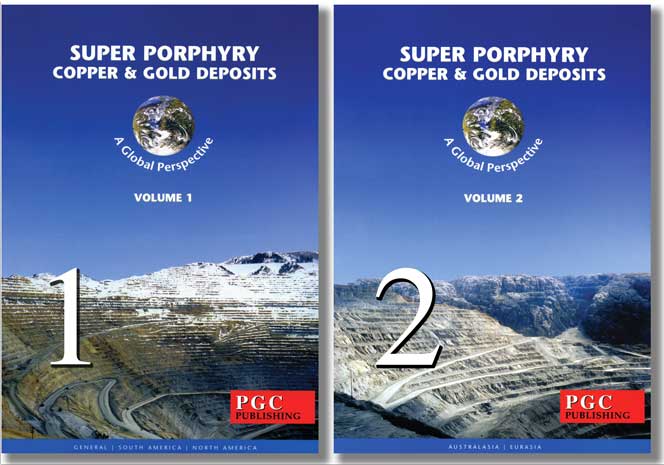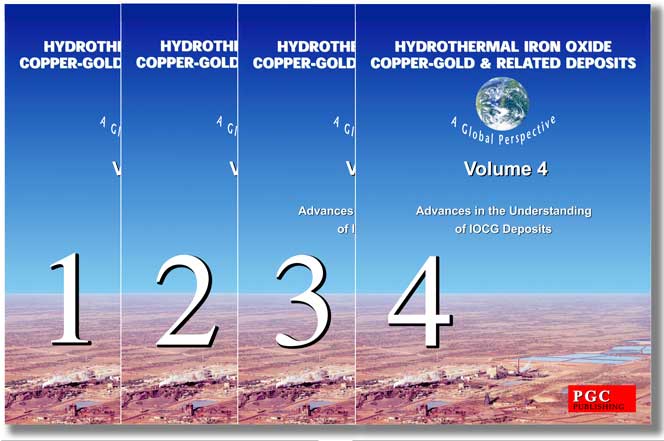|
Donlin Creek Project - Lewis, ACMA |
|
|
Alaska, USA |
| Main commodities:
Au
|
|
 |
|
 |
 |
Super Porphyry Cu and Au


|
IOCG Deposits - 70 papers

|
All papers now Open Access.
Available as Full Text for direct download or on request. |
|
 |
The Donlin Creek gold project, is located in the historic Kuskokwim Gold Belt of Southwest Alaska. It is ~400 km NW of Anchorage, 200 km NE of the inlet port of Bethel, and 15 km north of the village of Crooked Creek in southwestern Alaska (#Location: 62° 1' 53"N, 158° 7' 39"W).
Placer gold was first discovered at Snow Gulch, a tributary of Donlin Creek, in 1909, with subsequent intermittent small-scale placer gold production undertaken from then until 2014. Calista Corporation, an Alaska Native Corporation, secured the mineral rights to the Donlin Creek Project lands, which it has held since 1974. Resource Associates of Alaska carried out a regional evaluation for Calista in 1974 to 1975. Calista then undertook follow-up work between 1984 and 1986, including minor auger drilling in 1987. The first substantial exploration drilling program was carried out by WestGold in 1988 and 1989, culminating in an initial Mineral Resource estimate. Teck carried out a limited trenching and soil sampling program over the Lewis deposit of the project in late 1993, and updated the Mineral Resource estimate. Placer Dome Inc. acquired a 20-year lease from Calista from 1 May 1995, later extended to last until 2031, and explored the project area in more detail from 1995 to 2000. This work included geochemical sampling, geological mapping, geophysics, drilling and detailed metallurgical test work, as well as updating the Resource and Reserve estimates. Placer Dome Inc. formed the Donlin Creek joint venture with NOVAGOLD as operator in 2001. By November 2002, NOVAGOLD had earned a 70% interest in the Project. Placer Dome, reassumed management of the Property as operator in late 2002 and continued work to increase its interest. Barrick merged with Placer Dome in early 2006 and inherited the latter's interest in the JV and continued exploration, resource delineation and metallurgical testing in 2006-07. The JV partners formed Donlin Creek LLC in late 2007, with the subsequent name change to Donlin Gold LLC being adopted in 2011. An initial feasibility study was completed in 2007, updated in 2009, and then again in 2011. Between 2011 and 2020, additional work included resource infill and extension drilling, trenching, geotechnical work, metallurgical testing (Source: Novagold NI 43-101 Technical Report, 2021).
As detailed above, the project has been jointly owned by Barrick Gold and Novagold since 2006. However, in April 2025, Barrick Gold reached an agreement to sell the 50% interest in the Donlin gold project held through it's subsidiary Donlin Gold LLC, to affiliates of Paulson Advisers and NOVAGOLD Resources.
Mineralisation has been dated at ~70 Ma, and is hosted within the central section of the Late Cretaceous Kuskokwim flysch basin. This basin formed in the back section of an arc developed on an active continental margin. The continental margin was composed of previously accreted oceanic terranes and continental fragments. The basin is mainly filled with sandstone, siltstone and shale, underlain by a sequence that includes Proterozoic metamorphic, Palaeozoic clastic and carbonate, and Mesozoic marine volcanic rock. The Kuskokwim Group sedimentary rock sequence is intruded and overlain by Late Cretaceous and Early Tertiary volcano-plutonic complexes. The volcanic rocks comprise regionally extensive intermediate tuffs and flows that are dominantly andesitic, but may include dacite, rhyolite and basalt. Associated plutons are calc-alkaline in composition, ranging from monzonite to granodiorite. Felsic to intermediate subvolcanic granite to granodiorite porphyry dykes, sills and plugs, which are widely distributed, host gold mineralisation at Donlin Gold.
The Kuskokwim Basin was developed between two dextral continental-scale strike-slip fault zones, the Denali-Farewell Fault system on the southern side, and the Iditarod-Nixon Fork Fault system on the northern side of the basin. The initial displacement on these faults commenced early in the structural evolution of the region, and persisted over a long period, dominating the structural setting of southwest Alaska. Fold and thrust style deformation followed shortly after deposition of the Kuskokwim Group sediments. East vergent folds and thrust are common in the central Kuskokwim basin, including in the Donlin Gold area. Younger NNE trending folds were formed throughout the region in response to the basin-scale deformation. Most of the folds predate emplacement of the volcano-plutonic complexes. NE-striking normal and oblique slip faults were developed during the late compressional and extensional events that resulted in mineralising hydrothermal systems across the basin.
The Donlin Gold project deposits occur as a NE elongated ~1.5 x 3 km cluster, that locally persists over an ~1000 m vertical interval. The individual deposits are primarily hosted in igneous rocks and are associated with an extensive late Cretaceous hydrothermal system. Gold occurs in broad disseminated sulphide zones in rhyodacite and in vein networks. The two main Donlin deposits are known as ACMA and Lewis, representing different geological settings. The ACMA Deposit occurs in dykes and sills intruded into folded shale and siltstone rocks, whilst the Lewis Deposit is composed of dykes intruded into massive greywacke. Mineralisation in the ACMA deposit tends to be of higher grade and is more continuous than that at Lewis and other dyke dominated segments of the deposit. The most extensive and best-grade mineralised zones at ACMA are situated where 'feeder' dykes cut the sill sequence. Mineralised zones follow steeply dipping dykes and sills, and are open at depth with a vertical range of >1000 m.
Mineralisation occurs as structurally controlled NNE trending mineralised corridors composed of similar striking, high-angle fracture zones that are the primary control of gold-bearing veins. These mineralised corridors range up to 30 m in width and are hundreds of metres in length. They are hosted by a competent suite of hypabyssal, mainly rhyolitic to rhyodacitic, and commonly porphyritic intrusive rocks and similarly competent massive greywacke. The distribution of gold in the individual deposits mostly closely mimics the outline of the host intrusive rocks, which contain about 75% of the resource. Structural zones in competent sedimentary units account for the remaining 25%. This mineralised complex is part of a regional approximately 77 to 58 Ma magmatic arc.
Much of the information above is drawn from the Novagold website, viewed April 2025.
The deposit is subdivided into more than ten different prospects/deposits within the complex. Most are composed of dense quartz ± carbonate veinlet networks that fill NNE striking extensional fractures in the NNE trending igneous rocks. The principal alteration processes are sericitisation, carbonatisation and sulphidation, with the dominant sulphides being arsenopyrite, pyrite and younger stibnite. Gold occurs within the arsenopyrite and is refractory.
The Dome prospect on the northern margin of the cluster of mineralised locations comprises copper and gold bearing stockwork veins which are overprinted/cut by younger, lower temperature, auriferous veins that represent the main Donlin Creek gold mineralising event. The epizonal Donlin Creek deposits are interpreted as orogenic - intrusion related, and have many differences to epithermal or Carlin type occurrences. It has been suggested that the ore forming fluids were derived by either broad scale metamorphic devolatilisation above rising mantle melts or exsolution from a magma that was dominated by a significant flysch melt component.
Reserves and resources as at 12 April, 2012, (Novagold Resources Inc, website, 2012) were:
Proven + probable reserves - 504.8 Mt @ 2.09 g/t Au,
Measured + indicated resource - 541.3 Mt @ 2.24 g/t Au
Inferred resource - 92.2 Mt @ 2.02 g/t Au.
NOTE: Resources are inclusive of Reserves. Reserves are calculated at a 0.57 g/t Au cut-off, and Resources at a 0.47 gt Au cut-off.
The same resource and reserve figures are quoted on the Novagold website, viewed April 2025. To that date, the project remained un-developed.
For detail consult the references listed below.
The most recent source geological information used to prepare this decription was dated: 2021.
Record last updated: 2/5/2025
This description is a summary from published sources, the chief of which are listed below.
© Copyright Porter GeoConsultancy Pty Ltd. Unauthorised copying, reproduction, storage or dissemination prohibited.
|
|
|
|
|
Baker, T., Ebert, S., Rombach, C. and Ryan, C.G., 2006 - Chemical Compositions of Fluid Inclusions in Intrusion-Related Gold Systems, Alaska and Yukon, Using PIXE Microanalysis: in Econ. Geol. v.101, pp. 311-327.
|
Goldfarb, R.J., Ayuso, R., Miller, M.L., Ebert, S.W., Marsh, E.E., Petsel, S.A., Miller, L.D., Bradley, D., Johnson, C. and McClelland, W., 2004 - The Late Cretaceous Donlin Creek Gold Deposit, Southwestern Alaska: Controls on Epizonal Ore Formation: in Econ. Geol. v.99, pp. 643-671.
|
|
Porter GeoConsultancy Pty Ltd (PorterGeo) provides access to this database at no charge. It is largely based on scientific papers and reports in the public domain, and was current when the sources consulted were published. While PorterGeo endeavour to ensure the information was accurate at the time of compilation and subsequent updating, PorterGeo, its employees and servants: i). do not warrant, or make any representation regarding the use, or results of the use of the information contained herein as to its correctness, accuracy, currency, or otherwise; and ii). expressly disclaim all liability or responsibility to any person using the information or conclusions contained herein.
|
Top | Search Again | PGC Home | Terms & Conditions
|
|